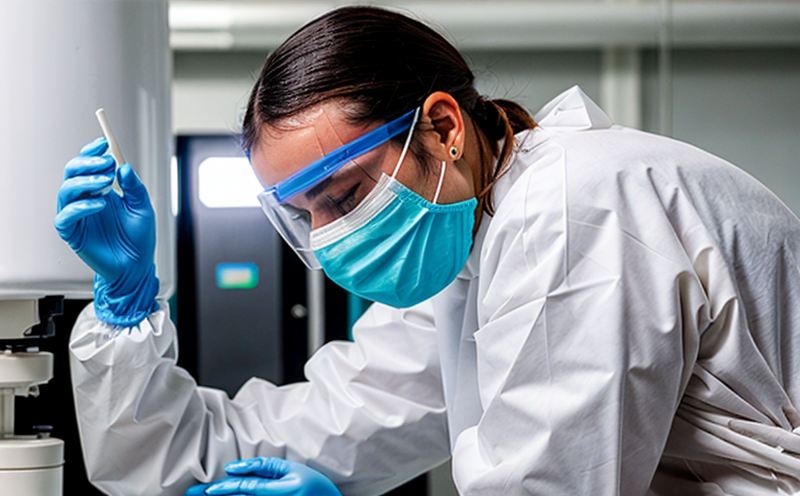ASTM E512 Photobiological Testing of UV Transmission in Lighting Glass
The ASTM E512 photobiological safety testing standard is crucial for ensuring the safe use of lighting glass products, especially those that may transmit ultraviolet (UV) radiation. This test evaluates whether a lighting fixture or glass component emits harmful levels of UV light when exposed to human skin. The primary objective is to prevent potential health risks such as sunburn, skin aging, and other dermatological issues.
The testing process involves subjecting the specimen to an artificial light source that simulates sunlight exposure. This procedure measures the amount of UV radiation emitted by the lighting fixture under various wavelengths. Compliance with ASTM E512 ensures that products meet international safety standards set forth by organizations like the American National Standards Institute (ANSI).
For accurate and reliable results, it is essential to follow strict specimen preparation guidelines prior to testing. Specimens should be cut into uniform sizes suitable for standard test chambers, ensuring consistent measurement throughout the evaluation process. Proper orientation of specimens within the chamber also plays a critical role in obtaining precise data.
The instrumentation used during ASTM E512 testing includes specialized spectroradiometers capable of detecting minute amounts of UV light across different spectral bands. These instruments provide detailed spectra plots that help determine compliance with specified limits outlined by ASTM standards. Additionally, software tools assist laboratories in interpreting raw measurement outputs and generating comprehensive reports.
Acceptance criteria for passing this test depend on the type of lighting glass being evaluated and its intended application. For instance, decorative indoor fixtures generally have stricter requirements compared to outdoor commercial signage or horticultural growth lamps. Laboratories must carefully examine final results against these predefined thresholds before declaring compliance status.
In summary, ASTM E512 photobiological testing plays a vital role in safeguarding public health by preventing excessive exposure to harmful UV radiation from lighting sources. By adhering to this rigorous standard, manufacturers can ensure their products comply with global safety regulations while maintaining aesthetic appeal and functionality.
- Guarantees compliance with international safety standards
- Reduces risk of skin damage due to UV exposure
- Enhances product reputation among consumers seeking safe lighting solutions
- Promotes trust between manufacturers and regulatory bodies
Applied Standards
The ASTM E512 photobiological testing standard is widely recognized for its comprehensive approach to evaluating the safety of lighting fixtures regarding UV transmission. This internationally accepted protocol forms part of a broader suite of standards designed specifically for electrical and electronic products, including those related to lighting technology.
Other relevant international standards include:
- ISO/IEC 17025 – General requirements for the competence of testing and calibration laboratories
- UL 8750 – Standard for safety of electric lamps and lamp fixtures (incorporating ASTM E512)
- CIE S 003/E – Recommended practice for the evaluation of photobiological safety of lighting products
By aligning with these stringent specifications, laboratories demonstrate their commitment to delivering accurate and consistent test results. Compliance with multiple recognized standards further strengthens a laboratory’s credibility within both domestic and international markets.
Benefits
Implementing ASTM E512 photobiological testing offers numerous advantages for manufacturers, distributors, and end-users alike. Here are some key benefits:
- Enhanced Product Safety: Ensures that lighting products do not pose a risk of skin irritation or other adverse effects from UV exposure.
- Improved Reputation: Establishes your brand as one that prioritizes consumer safety and well-being, enhancing customer trust and loyalty.
- Regulatory Compliance: Demonstrates adherence to industry best practices and international regulations, simplifying market entry processes globally.
- Better Decision Making: Provides detailed insights into the photobiological behavior of lighting fixtures, aiding in product development decisions.
- Increased Demand: Attracts buyers who value health-conscious products, potentially increasing sales volumes and revenue streams.
Competitive Advantage and Market Impact
Adopting ASTM E512 photobiological testing can significantly enhance a company's competitive edge in the lighting market. By demonstrating superior product safety, firms position themselves as leaders in innovation and consumer protection.
- Differentiation: Competitors may overlook this crucial aspect of lighting design, giving your organization a unique selling point (USP).
- Premium Pricing: Higher perceived value allows for premium pricing strategies, leading to increased profitability.
- Better Customer Satisfaction: Reduced complaints and returns translate into higher customer satisfaction scores.
In today’s competitive landscape where environmental consciousness is growing, showcasing commitment to photobiological safety can be a powerful marketing tool. Consumers are increasingly seeking eco-friendly and health-conscious products; being able to highlight adherence to such stringent testing protocols positions brands favorably in the eyes of environmentally aware consumers.





